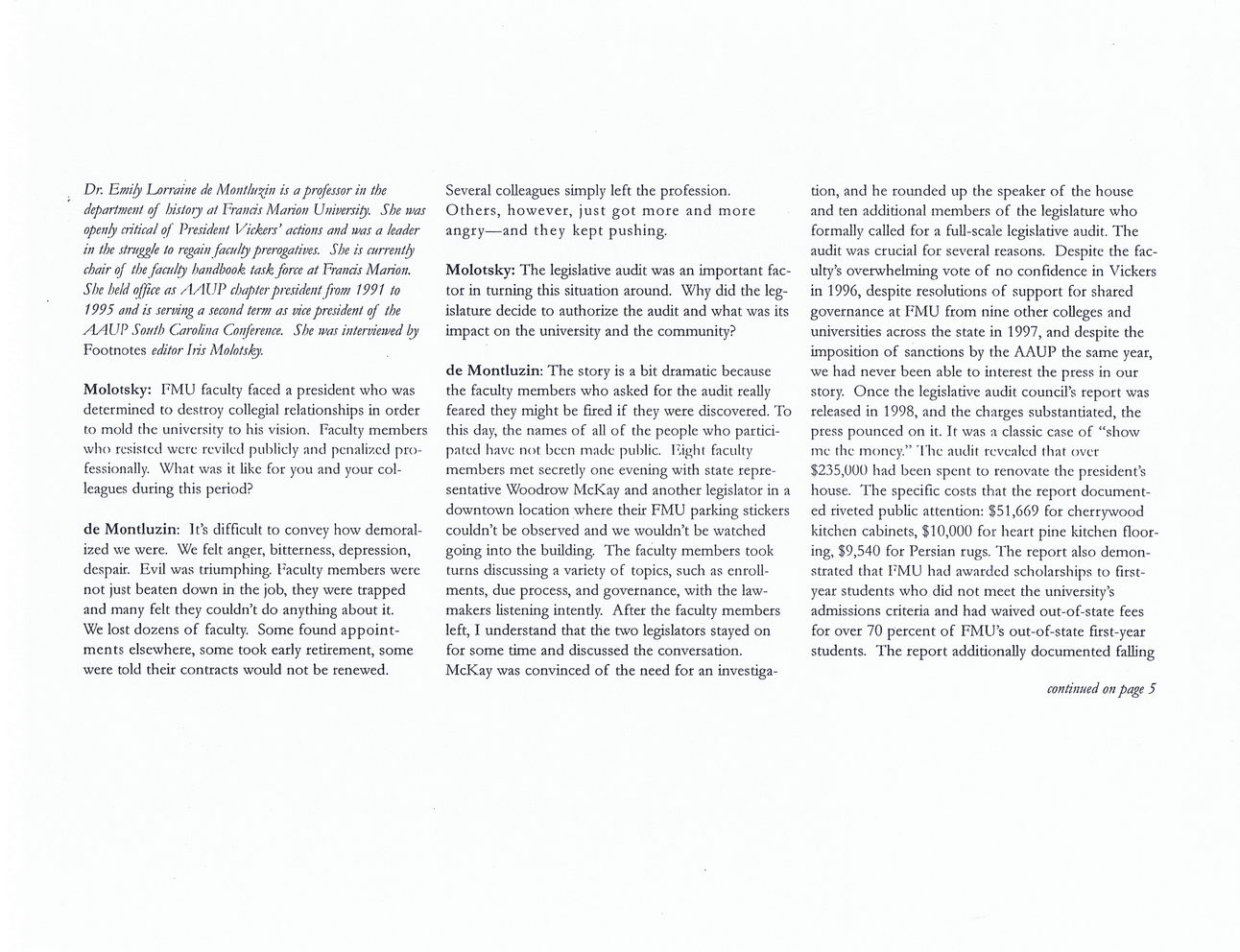This text was obtained via automated optical character recognition.
It has not been edited and may therefore contain several errors.
Dr. Emily Lorraine de Montluzin is a professor in the department of bistory at Frauds Marion University. She was openly critical of President Vickers' actions and was a leader in the struggle to regain faculty prerogatives. She is currently chair of the faculty handbook task force at Francis Marion. She held office as AAUP chapter president from 1991 to 1995 and is serving a second term as vice president of the AAUP South Carolina Conference. She was intervieived by Footnotes editor his Molotsky. Molotsky: FMU faculty faced a president who was determined to destroy collegial reladonships in order to mold the university to his vision. Faculty members who resisted were reviled publicly and penalized professionally. What was it like for you and your colleagues during this period? de Montluzin: It?s difficult to convey how demoralized we were. We felt anger, bitterness, depression, despair. Evil was triumphing. Faculty members were not just beaten down in the job, they were trapped and many felt they couldn?t do anything about it. We lost dozens of faculty. Some found appointments elsewhere, some took early retirement, some were told their contracts would not be renewed. Several colleagues simply left the profession. Others, however, just got more and more angry?and they kept pushing. Molotsky: The legisladve audit was an important factor in turning this situation around. Why did the legislature decide to authorize the audit and what was its impact on the university and the community? de Montluzin: The story is a bit dramadc because the faculty members who asked for the audit really feared they might be fired if they were discovered. To this day, the names of all of the people who participated have not been made public. High I faculty members met secretly one evening with state representative Woodrow McKay and another legislator in a downtown location where their FMU parking stickers couldn?t be observed and we wouldn?t be watched going into the building. The faculty members took turns discussing a variety of topics, such as enrollments, due process, and governance, with the lawmakers listening intendy. After the faculty members left, I understand that the two legislators stayed on for some time and discussed the conversation. McKay was convinced of the need for an investiga- tion, and he rounded up the speaker of the house and ten additional members of the legislature who formally called for a full-scale legislative audit. The audit was crucial for several reasons. Despite the faculty?s overwhelming vote of no confidence in Vickers in 1996, despite resolutions of support for shared governance at FMU from nine other colleges and universities across the state in 1997, and despite the imposition of sanctions by the AAUP the same year, we had never been able to interest the press in our story. Once the legislative audit council?s report was released in 1998, and the charges substantiated, the press pounced on it. It was a classic case of ?show me the money.? The audit revealed lhat over $235,000 had been spent to renovate the president?s house. The specific costs that the report documented riveted public attention: $51,669 for cherrywood kitchen cabinets, $10,000 for heart pine kitchen flooring, $9,540 for Persian rugs. The report also demonstrated that FMU had awarded scholarships to first-year students who did not meet the university?s admissions criteria and had waived out-of-state fees for over 70 percent of FMU?s out-of-state first-year students. The report additionally documented falling continued on page 5

de Montluzin, Emily Lorraine Color-011